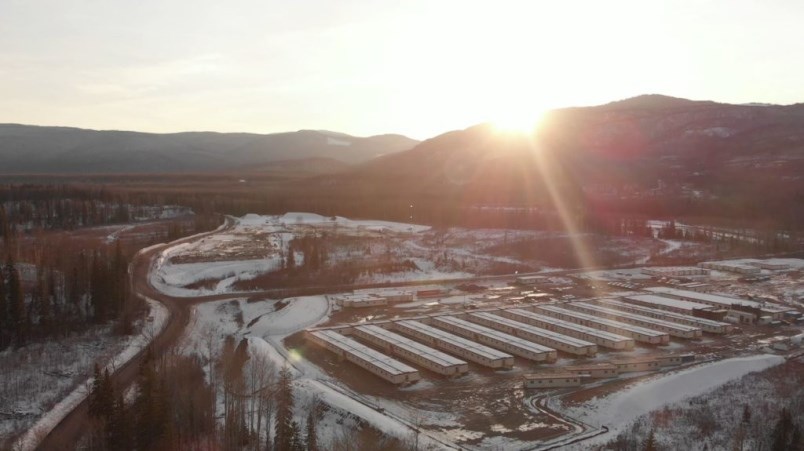Continued construction of the Site C dam and the Coastal GasLink pipeline are expected to carry Northern B.C. through its economic recovery from the COVID-19 pandemic, according to the latest economic outlook from the Northern Development Initiative Trust.
The NDIT released its 2021 State of the North economic report on Wednesday, saying mining, natural gas exploration and production, as well as improved commodity prices are also expected to help support employment in the region.
“This year’s State of the North contains good news, bad news and a lot of uncertainty,” NDIT CEO Joel McKay says in a release. “Our region is faced with labour shortages, slow population growth and a myriad of other risks from floods, fires and a war in Eastern Europe. However, major project constructions along with strong commodity prices will likely continue to support various industry sectors for the next few years.”
The northeast has already been buoyed by major projects during the pandemic, with the NDIT noting regional unemployment recovered “particularly quickly” from the first wave of lockdowns due to strong employment growth. Unemployment was at 6.3% in 2019 leading into the pandemic, peaked at 11.1% in May 2020, and had dropped to 4.6% by the end of 2021.
“The construction, forestry and mining sectors experienced strong gains in 2021, which was likely linked to re-hiring at the Site C dam as well as an increase in drilling activity due to improvements in the price of natural gas,” the report says.
But the return to work hasn't come without its challenges, with the NDIT reporting the working age population in the region stayed relatively stable while the labour force declined between 2019 and 2021. Population levels also stayed “relatively stable,” the report says.
“This suggests that some people in these regions have chosen not to seek employment, which may reflect concerns about workplace safety, exposure to the COVID-19 virus, or not being able to meet vaccine requirements for potential employers,” the report says.
Looking ahead, the NDIT is signalling positive growth for natural gas production. It says market prices are expected to remain strong, driven by Chinese demand, while wells drilled for LNG export are expected to continue to increase as the LNG Canada facility, now more than 50% built, marches toward completion.
“Extreme weather events and the inconsistent nature of renewable energy is expected to support demand for reliable backup energy sources, like natural gas, in the short to medium term,” the report says.
In forestry, harvest volumes were up in 2021 but mills in the region have been stymied by transportation shortages this year, particularly at Taylor pulp, which has been curtailed since mid-February. Meantime, the schedule at the Fort St. John sawmill has been reduced to four days a week, and the NDIT adds the impact of old growth logging deferrals in the north is "uncertain at this time."
“Lumber prices are expected to remain at or above current levels, while a return to the peak prices seen in early 2021 is unlikely,” the report says. “However, there remains considerable uncertainty in the pulp sector as the lack of fibre supply has led to mill closures. Additionally, ongoing supply chain issues were made worse by the significant wildfires in 2021 which disrupted transportation and led to logging curtailments.”
Other sectors face extreme challenges but also opportunities. For agriculture, the NDIT notes northeast farmers—who produce 80% of B.C.’s grain and oilseed crops—faced a challenging 2020 with poor yields driven by extreme summer drought. As farmers recover, they're also bracing for increased input costs this season, from fuel to taxes to fertilizers, and the Peace River Regional District lobbies the provincial government for relief.
“Producer deliveries of wheat declined by 21 per cent compared to 2019 due to poor weather conditions,” the report says. “Data from 2021 indicates another difficult year as wheat deliveries were down 31 per cent between January and October, compared with the same period in 2020.”
In mining, the NDIT says prices for metallurgical coal increased in 2021 as Chinese steel production recovered to pre-pandemic levels. “Looking forward, B.C.’s mining sector is expected to continue to be supported by favourable commodity prices leading to increased exploration and improved economic activity,” the report says.
And as for tourism, the NDIT says the reopening of borders to non-essential travel is expected to lead to a significant increase in visits, particularly from British Columbians — welcome news after “a particularly bad wildfire season” limited travel to the north last summer.
“Travel restrictions during the winter months also restricted recreation-based travel to the Northeast region for skiing and snowmobiling," the report says.
"Looking forward, rising oil prices will increase the cost of all modes of travel. This may delay the return of out-of-province visitors and encourage more B.C. residents to vacation within the province in 2022. For Northern B.C., this may lead to higher levels of visitation at key attractions.”
And though more people in the region are working today in accomodation and food services than in 2019, the NDIT notes, “tourism operators are facing staffing difficulties amid a reshaping of the labour market, that could limit capacity in the sector in the near-term.”
Read the report in full below:
State of the North 2021 Report by AlaskaHighwayNews on Scribd
Have an opinion? Send your letters to [email protected]



